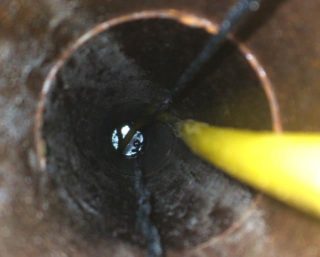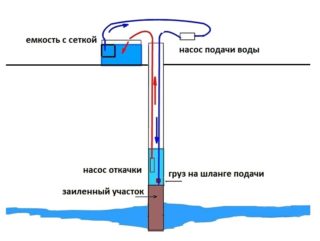Suburban settlements often do not have centralized water supply. Therefore, the site owners resort to the device of autonomous sources - wells or wells. In most cases, there are no problems with the flow rate of a hydraulic structure. But there are situations when water leaves the well after winter or after some time from the beginning of its operation. It is necessary to deal with the problem, otherwise the source will completely stop working and you will have to drill a new hole.
Reasons for a decrease in the amount of water in the well
Well depth and its hydrogeological parameters

It is about the level at which the water intake point is located relative to the surface of the earth and other aquifers. The most unfavorable in terms of the constancy of the flow rate are considered to be hydraulic structures on the top (the very first aquifer) or on the sand. Here, the layers are considered to be free-flow or low-pressure, the resource in them directly depends on the amount of precipitation. The more there are, the higher the liquid mirror in the well will be.
In dry seasons, the flow rate of the source is seriously reduced. It is important to pay attention to the atmospheric pressure drops, at which the amplitude of water fluctuations in the reservoir can reach 1 meter. Additionally, you can take into account: if several neighboring wells are located on one horizon, the resource may simply not be enough for all. Especially during dry seasons and periods of garden watering.
If the source is drilled into limestone, such a layer is considered to be confined. The quality of the liquid in it is better. But even here, two or three adjacent hydraulic structures can suffer considerably in terms of productivity.
Filter problems
Improper arrangement of the filter system near wells for sand also often leads to a decrease in the volume of water in the mine. This may be due to improperly selected mesh cells, which are wrapped around the perforated bottom end of the column. Too small holes are clogged with grains of sand quickly (calmotage is formed), which leads to a decrease in well productivity. Sand fills the bottom of the casing through the large meshes and interferes with the free flow of water. The same happens when the filter mesh breaks.
In an artesian source, mesh windings are not placed. However, here the problem of the collapse of limestone strata may arise and, as a consequence, the blocking of the well string. Water will flow into it with difficulty.
Improper well operation
The more consistent the use of the source, the longer and better it works. With regular movement of water, silting of the lower part of the casing string is excluded. If the source is used seasonally, after the winter the well gives little water, since the filter is silted up and requires flushing.
The wrong operation of the well also has a downside - the overestimation of the requirements for the productivity of the source. Too powerful pumping equipment draws more water than the hydraulic structure allows according to the documents. With this approach, too fast fluid movements lead to the fact that a special sump pocket under the filter is quickly clogged with rock particles. This clogs the casing at the bottom of it. The result is that the intake part of the shaft is seriously reduced in diameter.
For each specific flow rate of a hydraulic structure, it is necessary to take a pump with precisely selected technical characteristics in terms of power and performance.
Ways to solve the problem

To understand how to deal with the low flow rate of a previously active source, you need to identify the cause of the situation. Then proceed to solving the problem sequentially.
When the bottom is silted, you will have to flush it under high pressure. Here you need to use special equipment for water hammer and a compressor. It is better to entrust this work to specialists. If the gelation (flushing) is carried out on our own, without experience and knowledge, there is a high risk of damaging the casing with a water hammer or aggravating the situation with incorrectly selected reagents. Pumping is performed for 5-10 hours, while removing waste water with sludge in parallel. The same should be done with the new well. This is called source swing.
With regular silting of the bottom, the well stops working after five years. Therefore, most likely, it will be necessary to prepare for drilling a new wellbore. In addition, the silting up of a new source in the first year of operation is a serious cause for panic. Apparently the foremen who were engaged in the arrangement of the casing made gross technological mistakes.
If the reason for the low flow rate of a hydraulic structure is filter clogging, it is better to change it. Moreover, it is desirable to choose the optimal size of the grid cells. After replacing the filter, you will also have to flush the well in order to increase the flow of water into the shaft of the mine.
When several sources are located on one aquifer, it is necessary to deepen below or find compromise solutions with neighbors for the rational use of water.
Preventive measures
To maintain optimum source performance, the following preventive measures should be followed:
- Once every 2-3 years, flush (swing) the well, even if at first glance it gives a sufficient amount of water.
- When drilling a source, it is necessary to accurately calculate the flow rate of the aquifer and select the correct equipment and components for the arrangement of a hydraulic structure.
- Sand springs are best done with a diameter of 15 to 21 cm.
- The casing should extend below the water level in the shaft.
- It is important to make a sufficient number of perforations in the bottom of the pipe. You also need to choose the correct mesh size for the filter.
- The pump is placed in a new well at least one meter from the bottom and 50 cm from the water surface.
- The pumping equipment in the first days of operation of the source must work continuously. This will help to properly shake the hydraulic structure.
- It is advisable to use the source in winter as well. Continuous water flows prevent silting of the bottom of the column.
By observing all these recommendations, it is possible to avoid problems with a low flow rate in the well.








